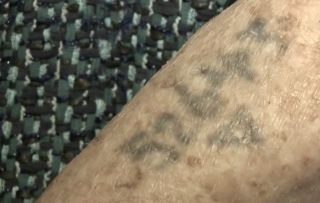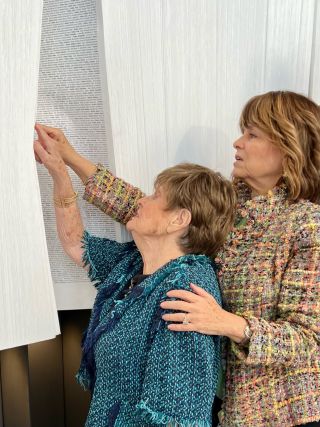Trauma
How Do Holocaust Survivors Cope With Extreme Trauma?
Some never cry.
Updated February 28, 2024 Reviewed by Hara Estroff Marano
Key points
- Bronia Rubin Brandman survived unimaginable horrors at the hands of the Nazis.
- The inability to cry is not uncommon among survivors.
- Many Holocaust survivors refused to speak about it for decades. Silence can be a healthy coping strategy.
- The Book of Names is a memorial installation from Yad Vashem.
"And to them will I give in my house and within my walls a memorial and a name (Yad Vashem)” —Isaiah 56:5
Bronia Rubin Brandman was twelve when she and her three sisters were sent to Auschwitz. When they arrived, they filed past Josef Mengele, a Nazi known for his extraordinary cruelty. Pointing his white-gloved hand, Mengele directed her older sister, Mila, then 20, to a separate line. Without thinking, Bronia ran after her. As soon as she reached her older sister, she realized what she had done. Their younger sisters, along with all of the other children, were marched from the cattle car to the gas chamber.
Bronia didn't cry.
She had escaped death once already. A year earlier, the Jews of Jaworzno, her hometown in Poland, were commanded to report to the schoolyard. Her older brother, Mendek, had been sent to a slave labor camp. Mila and their younger sisters had gone into hiding in a nearby town. Bronia, her brother Tulic, and her parents reported to the schoolyard, which was surrounded by soldiers with dogs. When they arrived, realizing they were marked for death, her mother whispered to Bronia to run. If she ran, Bronia thought, she would surely be shot. Quietly separating herself from her family, she slowly walked out of the schoolyard.
She didn't cry.

When I asked her what she was thinking and feeling as she made her escape, she told me that she hadn't known whether she would make it out alive. She knew she would never see her parents or her brother again. But “nobody cried,” she said. Long before that day, antisemitic schoolchildren had called Bronia a “dirty Jew” and told her to “go back to Palestine.” By the time her family was taken away, all the Jews of Poland had seen unimaginable horrors. Bronia saw one group of Jews marched to a synagogue and burned alive. Others were slaughtered and hung on meat hooks…
Everyone in the schoolyard that day was sent to the gas chambers to die. Jaworzno was declared “Judenrein,” cleansed of Jews. A year later, the four sisters along with the remaining Jews of the neighboring town were sent to Auschwitz. That town, too, was declared “Judenrein.”
Before long, Mila contracted typhus and was sent to the barrack for sick Jewish women. Bronia found a way to accompany her. One day, Bozenka Teinerova, the barrack's nurse, confided in Bronia that all the sick women would soon go to the gas chambers. Bronia didn't know how to say goodbye to her sister. She couldn't face her. Bozenka took Bronia to a different barrack, and Bronia never said goodbye.
Having first left her parents and brother on their way to the gas chamber, then her two younger sisters, and finally her older sister, Bronia felt she did not deserve to live. She told herself that she would never laugh again— and that she would never cry.
An inability to cry is not unheard of among Holocaust survivors. The extreme trauma they experienced and the inconceivably cruel and gruesome atrocities they witnessed can require extreme coping mechanisms.
Bronia, now 91, and her brother, Mendek, survived. Mila did not. Her name, along with the names of Bronia’s younger sisters, her brother Tulic, her parents, her mother’s eleven siblings, and dozens of other relatives are inscribed in Yad Vashem’s Book of Names, an exhibit containing the names, birthdates, hometowns, and places of death of 4.8 million of the approximately 6 million Jews murdered by Nazis and their collaborators. A thin shaft of light illuminates each page, and blank pages at the end symbolize the people whose names have not been recorded. On loan to the United Nations until February 17, the installation was inaugurated on January 27: International Holocaust Remembrance Day.
“Inaugurating The Book of Names at the United Nations Headquarters on the eve of International Holocaust Remembrance Day is extremely significant and poignant,” said Yad Vashem Chairman Dani Dayan, “especially in light of the alarming growing global trends of Holocaust trivialization and distortion as well as antisemitism.”

For 50 years after the war, Bronia refused to speak about her experiences. This is not an unusual reaction for Holocaust survivors, among whom survivor guilt is common, even possibly leading to suicides. In contrast with many contemporary approaches to trauma, some psychologists have found that for the extreme trauma of the Jewish Holocaust, suppression has been, in many cases, a coping strategy that allows survivors to “adapt and adjust.”
In 1997, enough time had passed that Bronia decided to start talking. With the dramatic increase in antisemitism in the U.S., she is not planning to stop. According to the Anti-Defamation League, antisemitic beliefs are at their highest level in decades. An ADL Center for Antisemitism Research study released in January found that 85% of Americans believe at least one anti-Jewish trope, up from 61% in 2019, and 20% of Americans believe six or more antisemitic tropes. That number was 11% in 2019.
“Antisemitism is rearing its ugly head all over the world,” Bronia despairs. “It’s on the streets, in the media, and in the halls of Congress.” She is determined to speak out. “The world was totally indifferent to what was happening then. And they are indifferent now.”
I asked Bronia whether, in all the years since the war, she has ever allowed herself to laugh or cry. Twenty-five years after the war, she said, when she visited Israel, “I was so proud. It empowered me to laugh.”
She still cannot cry. ♦
The Book of Names will be on display in the UN Headquarters in New York through February 17, 2023. At the conclusion of its display at the United Nations, The Book of Names installation will be brought to Israel to be permanently included in Yad Vashem's Museum's Complex on the Mount of Remembrance, and will open to public viewing in time for Israel's Holocaust Remembrance Day, observed this year on April 17-18, 2023.




